
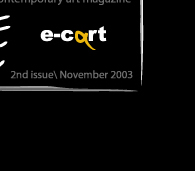




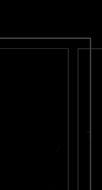









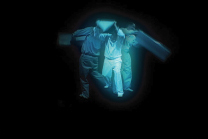
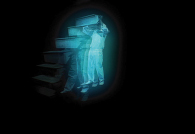

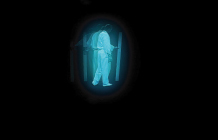


The work parallels an early quantum observation made by Physicist Niels Bohr, wherein the Quantum Wave nature of matter was first discovered. The circular configuration of the installation, the discontinuous movement and subtle quantum jumps made by the objects at its center, as well as the flashes of light, all find inspiration from observations made by physicists at the start of the quantum movement. These early quantum observations revealed the world to be a place of conflicting truths, in which physical laws such as continuity and locality were shown to be true and false at the same time.
Such a conflict of interpretation is called a tangled hierarchy, wherein a contradiction of truths forces a break from the classical laws of order and logic by which we interpret the world through experience.
The value of these insights into such classically accepted divisive reasoning as true or false, or the particle/wave nature of matter itself, is that such insights eventually lead us to a union between subject and object, the separation of which is the anchor of material reality and dualism.
Regarding the Istanbul Biennial; this is what Poetic Justice is for me, a state of mind, wherein our relationship with ideas and objects and even with ourselves as object/observer exists in an edgeless gap between pairings. These issues, whether expressed using social, creative or scientific terms, more directly touch upon the human experience than any other. Ultimately, what is true for the electron is true for the atom is true for the cell is true for matter is true for the person is true for the nation is true for the world.
Below is an outline detailing the manner in which these issues are addressed
within the installation:
From the start, references to Bohr's early quantum observations of an atom
are made through comparison with the circular orbit of electrons around an
atomic nucleus, as well as electrons flickering in and out of material reality
as they jump orbit. In the atomic model, the electrons alternate between their
particle and wave states, and when they appear as particles, they emit a Quanta
of light, an actual burst off energy (the energy that drives everything),
thus the figures shown in the installation flash as they jump from one spot
to another while orbiting within the drum.
At the start of the sequence, there is one figure moving in orbit while holding two objects; a long post and a rectangular block. Soon after, the figure splits into two identical forms, each holding one of the two objects. At this point the figures are the same, only they have developed behavioral difference and carry different objects. These pairings trigger an initial, very subtle oscillation.
The figures begin to spin and twirl the objects as they walk, a reference to the up and down spin of electron pairings. The figures stop and begin to build what I call perceptual constructions using the objects they're carrying. The block of wood is shown in rapid succession - forming the image of a staircase, and the post is shown in rapid succession - forming the image of a fence. It is critical to note here that there is no image of an actual fence, but we see one - there is no image of an actual staircase, but there is because we see it. In a manner of speaking, the particle (post), and the particle (step) are seen redundantly as waves, which, when perceived together form the image of something that no single post or step could ever be, yet is anyway. Thus the particle/wave paradox is experienced.
My intention is for a tangled hierarchy to arise when we try to resolve the inevitable question; where does the image of a fence stop and the image of a post begin? Where does the perception of stairs stop and the perception of a step begin? Which is true?
Finally, The fence and stairs were chosen as objects because they embody a sense of progress and obstruction in terms of movement from a high orbit to a lower one, as well as the barriers or lines that divide these orbits. Together the fence and stairs form a pairing, which, when inverted (stairs going down rather than up - taking the fence down rather than building it up), retains it's paradoxical relationship.
Peter Sarkisian
|
|
|
|||||||||||||||||||||
 |
 |
|
|
|||||||||||||||||||
|
|
 |
 |
|
|||||||||||||||||||
 |
 |
 |
|
|||||||||||||||||||
 |
|
|||||||||||||||||||||
|
|
|
|||||||||||||||||||||
 |
|
|
||||||||||||||||||||
|
|
|
|||||||||||||||||||||
 |
 |
 |
|
|||||||||||||||||||
|
|
|
|
|
|||||||||||||||||||
|
|
|
 |
|
|||||||||||||||||||
|
|
|
 |
|
|||||||||||||||||||
|
|
|
|||||||||||||||||||||
| |
|
|||||||||||||||||||||
|
|
|
|||||||||||||||||||||
|
|
 |
|
||||||||||||||||||||
 |
|
|||||||||||||||||||||
|
|
|
|||||||||||||||||||||
|
|
 |
|
|
|||||||||||||||||||
|
|
 |
 |
|
|||||||||||||||||||
|
|
 |
|
|
|||||||||||||||||||
 |
|
|||||||||||||||||||||
 |
|
|||||||||||||||||||||
|
|
|
|||||||||||||||||||||
|
|
|
|
|
|
|
|
|
|
|
|
|
|
|
|
|
|
|
|
|
|
|
|